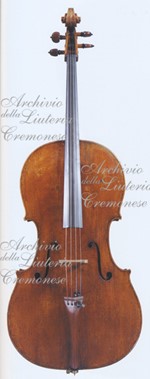1712 - Cello "Bass of Spain"
Back of two pieces of curly maple on medium curl, glued in a herringbone pattern with apex at the top.
- 1712, Cremona
- 75.6 cm
- 34 cm
- 22.75 cm
- 43.5 cm
- David L. Fulton Collection, Chicago (USA)
- Dendrochronological analysis by John C. Topham, Surrey: youngest ring is 1702
- Truls Mørk 2003; Joshua Roman 2007
- The cello was for many years the property of an unidentified family in Madrid, Spain, from which derives the name given to the instrument. Between the years 1830-40 would be entrusted for a restoration to luthier Xavier Ortega in Madrid, who he would substitute the soundboard, exposing the original one in the glass front of his shop. The French luthier George Chanot, passed from Madrid, he would have seen the relic being able to take him to Paris, where he would be seen by the famous Italian trafficker Luigi Tarisio, that him purchased and would able know the origin. He then went to Spain to recover the rest of the instrument, bringing the pieces at Vuillaume, in Paris, that they would be reassembled and purchased, and then sell the instrument to a Russian nobleman. These dead, the instrument was sold in 1876 to David Laurie.
- 1830-40, Silverio Ortega, Madrid; metà sec. XIX, Jean-Baptiste Vuillaume, Paris
- Luigi Tarisio; Jean-Baptiste Vuillaume (Paris); David Laurie (Glasgow) 1876-1877; John Adam 1877; Duc de Camposelice 1882-1887; Franklin Singer 1887-1902; Michael Antonacci 1954; Hermann Walecki 1958-1966; Juan Luis Prieto (Mexico City) 1979; Yasukaze Chaki (Japan) 1988; Bernard Goldblatt 1988; David L. Fulton 1999
- 1966, New York: Loan Exhibition of Stringed Instruments and Bows; 2004, Cremona: I violoncelli di Antonio Stradivari; 2012, Oxford: Stradivarius
- Hart 1885; Hill 1902; Doring 1945; Hamma-Wanna-Wurlitzer 1966; Goodkind 1972; Gand 1994; Dilworth 2000; Bein 2002; AA.VV. 2004; S.a. 2005; Pollens 2010; AA. VV. 2012
Immagini
| creato: | martedì 23 ottobre 2012 |
|---|---|
| modificato: | giovedì 23 marzo 2017 |



